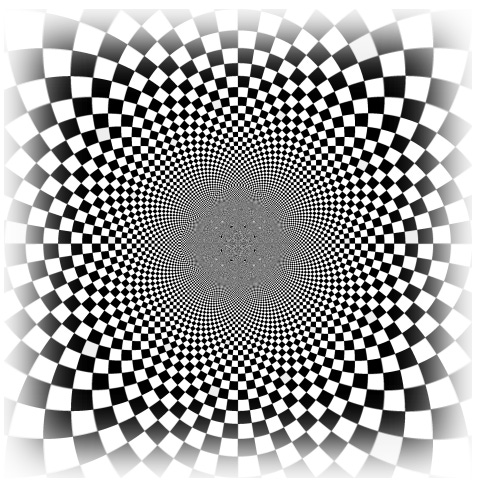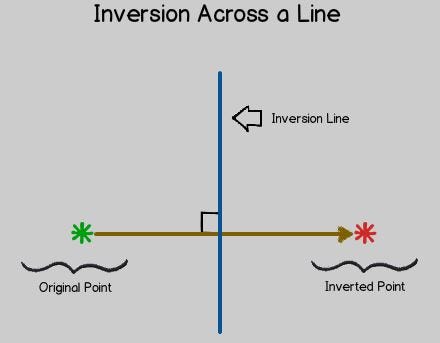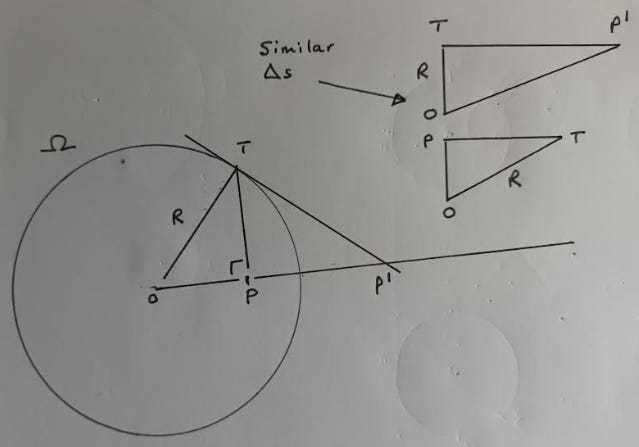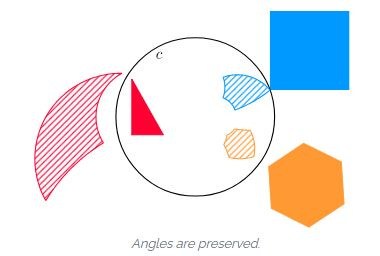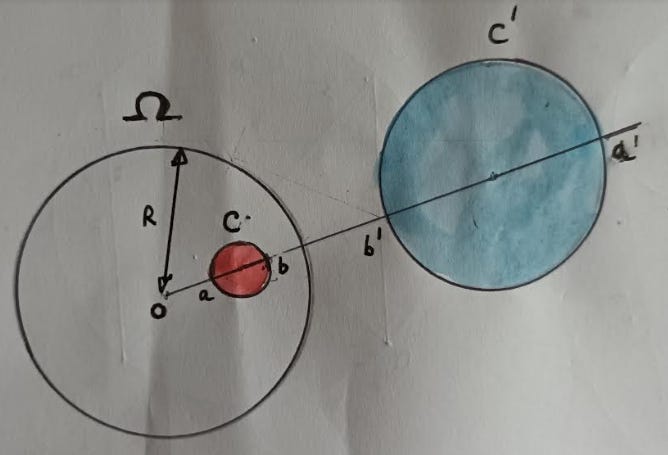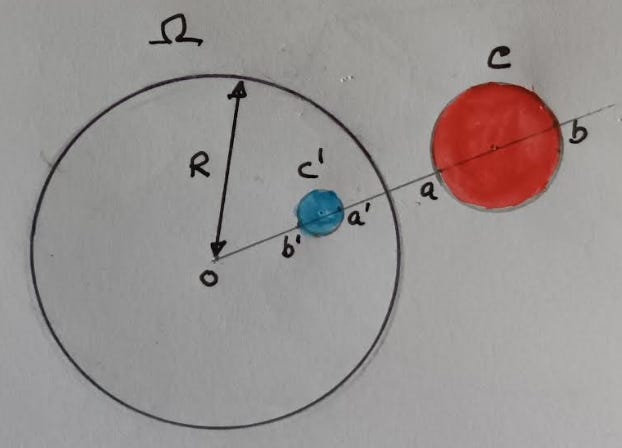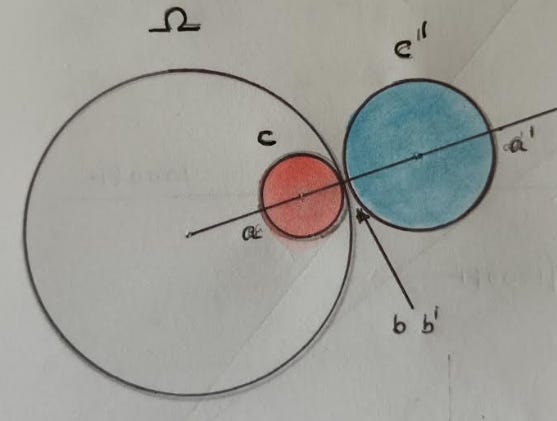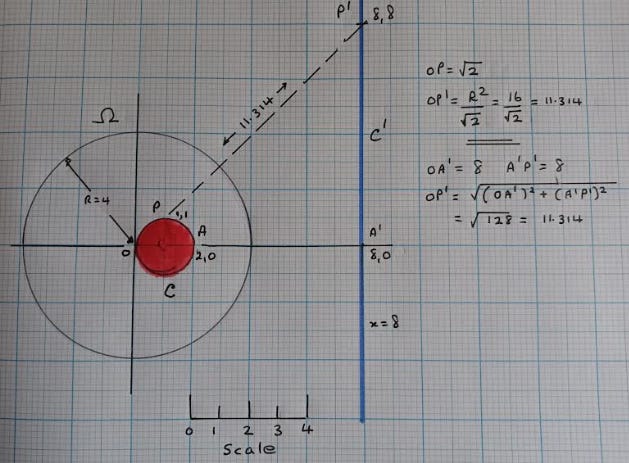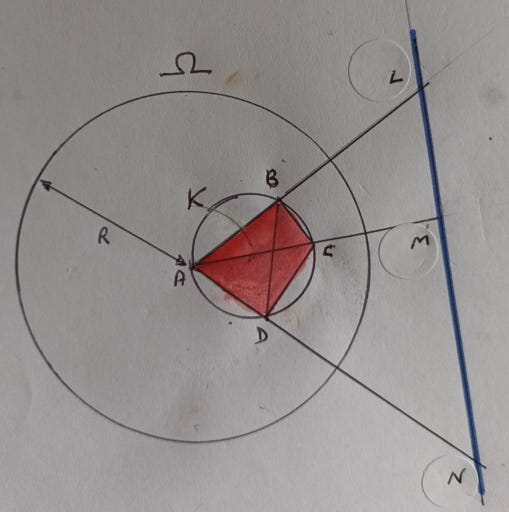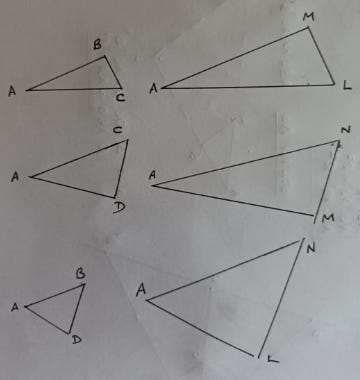This Viewpoint takes a look at Geometric INVERSION - a powerful technique for solving various problems and one rarely covered in school courses even at “A” level.1 The Viewpoint also shows how inversion provides an elegant proof of Ptolemy’s Theorem - (earlier Viewpoint).
The next image shows a vertical blue line - labelled Inversion Line. If the green point to the left is “inverted”, it becomes the red point to the right. In this case, the inversion is essentially a reflection. The inversion of the red point is, of course, the green point. The red point and green point are equidistant from the blue line.
Inversion with respect to a circle
The more usual geometric situation is inversion with respect to a reference circle.
In the next diagram, P is a point inside reference circle Ω with centre O and radius R units. A “ray” is drawn from O through P and outwards beyond the circumference of Ω. PT is a straight line at right angles to OP and intersects the circumference of Ω at T. O is joined to T and a tangent to the circle is drawn at T. This tangent cross the “ray” at point PI and that is the inverse of point P with respect to the circle. The inverse of PI is P.
Note that there are two similar triangles OPT and OTPI and from those triangles
OPI / R = R / OP and therefore OP.OPI = R2
That is the formula for circle inversion.
Using the formula, any point (such as P) within the circle can be mapped to a point P1 outside the circle (and vice versa).
If P is a point on the circumference of Ω then the inversion of P is the same point. In other words, points on the circumference of the reference circle are invariant under inversion.
As point P gets closer to the centre of the reference circle Ω, the inversion of P gets increasingly distant from Ω - the distance tends to infinity.2
Shapes can be inverted by inverting points on the boundary of the shape. A very important property of this type of inversion is that angles are preserved. As a consequence of angle preservation, objects that are tangential to each other, are inverted to objects that are also tangential to each other.
A circle, inverts to a circle.
In the next diagrams, the reference circle is Ω and the circle to be inverted is C (shown red). The resulting inversion is C1 (coloured blue).
Example 1] C within the reference circle inverts to C1 outside Ω
Example 2] C outside the reference circle inverts to C1 inside Ω
Example 3] C inside and tangential to the reference circle inverts to C1 outside and tangential to Ω - (the point of tangency b b1 is invariant
Example 4] If the circle to be inverted C touches the centre O of the reference circle Ω then C inverts to a straight line C1 (shown in blue). (The straight line is regarded by some mathematicians as a circle with infinite radius. Adopting that view enables them to say that circles always invert to circles).3
Proof, using inversion, of Ptolemy’s Theorem
Ptolemy’s theorem is that, for a cyclic quadrilateral (vertices A, B, C, D)
AB.CD + AD.BC = AC.BD (see (earlier Viewpoint).
The following proof uses inversion and also the properties of similar triangles.
The next diagram shows a cyclic quadrilateral ABCD (coloured red) within a circle (K) and K is within the reference circle Ω (of radius R). Point A is both a vertex of the quadrilateral and the centre of the reference circle. This fact means that the inversions of points B, C and D lie on a straight line (coloured blue). The inversions of B, C and D are shown as L, M and N respectively.
Step 1 - From the definition of inversion AB.AL = R2 and AC.AM = R2 and AD.AN = R2
Step 2 - Triangles ABC and AML are similar because AB.AL = AC.AM from which AB / AC = AM / AL and also angle CAB is common to both triangles.
The same reasoning tells us that triangles ADC and AMN are similar and triangles ABD and ANL are also similar.
Step 3 - Find expressions for the lengths LM , MN and LN
Because of similarity between triangles ABC and AML
LM / BC = AL / AC and therefore LM = (BC . AL) / AC
but AB.AL = R2 and so LM = (BC.R2) / AB.AC
Applying the same reasoning to triangles ADC and AMN shows that
MN = (CD.R2) / AC.AD
and, for triangles ABD and AD1 B1
LN = (BD.R2) / AD.AB
Step 4 - Note that LM + MN = LM and so
(BC.R2) / AB.AC + (CD.R2) / AC.AD = (BD.R2) / AD.AB
Step 5 - Simplify
Divide both sides by R2 gives
BC / AB.AC + CD / AC.AD = BD / AD.AB
Now multiply both sides by AB.AC.AD and with slight-re-arrangement
AB.CD + AD.BC = AC.BD
which proves Ptolemy’s theorem for the cyclic quadrilateral ABCD.
Many other proofs of Ptolemy’s theorem are available but the proof by inversion has a particular elegance. Here is another proof using complex numbers
Various links:
What is the Inverse of a Circle? (mattferraro.dev) - good graphics
Inversion in a circle - Michael Hansen (2010) pdf (synesthesiam.com)
Art of Problem Solving - Circular Inversion
Inversion - Advanced Euclidean Geometry - Mathematics LibreTexts
Inversion Geometry Math Review | Finish The Shot
Preservation of Angle Measure - Circle Inversions (weebly.com)
Inversions of Circles and the Angles Between Circles (washington.edu)
Circular Inversion – Reflecting in a Circle – IB Maths Resources from Intermathematics
Ptolemy's Theorem (cut-the-knot.org)
Ptolemy by Inversion (cut-the-knot.org)
A Miraculous Proof - Ptolemy's Theorem from Numberphile
Inversion - Michael P. Hitchman - from Geometry with an Introduction to Cosmic Topology
Video - INVERSE GEOMETRY: Find the inverse of the circle | Easy way to tackle with difficult problems (youtube.com)
More difficult material
What is InversiveGeometry.pdf (osu.edu) - (Note -
inversion ina circle.dvi (geometer.org)
Inversion (whistleralley.com)
inversionSupplement.pdf (uga.edu) - Circle Inversions and Applications to Euclidean Geometry
Non-euclidean.pdf (washington.edu)
Geogebra
Inversion of the line – GeoGebra
Circle inversion interactive – GeoGebra
For example, 597421-2023-2025-syllabus.pdf (cambridgeinternational.org)
OP.OPI = R2 and so OPI = R2 / OP
The point is discussed in, for example, inversion.dvi (geometer.org)

